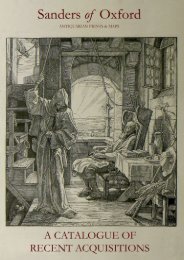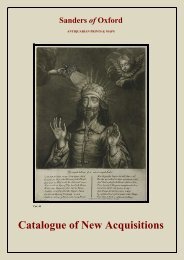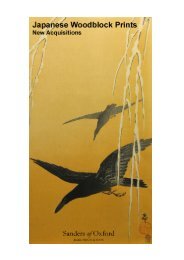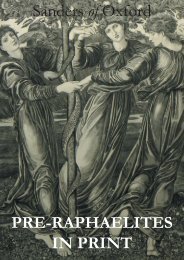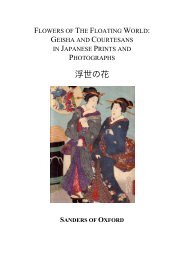Mezzotints & Engravings after J.M.W.Turner.pdf - Sanders of Oxford
Mezzotints & Engravings after J.M.W.Turner.pdf - Sanders of Oxford
Mezzotints & Engravings after J.M.W.Turner.pdf - Sanders of Oxford
You also want an ePaper? Increase the reach of your titles
YUMPU automatically turns print PDFs into web optimized ePapers that Google loves.
28. [The Mouth <strong>of</strong> the Thames]<br />
Mezzotint<br />
Frank Short <strong>after</strong> J.M.W <strong>Turner</strong><br />
Published by F.Goulding, c.1891<br />
Image 301 x 427 mm, Plate 318 x 439 mm, Sheet<br />
390 x 480 mm<br />
unmounted<br />
Engraver’s pro<strong>of</strong> before all letters.<br />
Signed to lower right side <strong>of</strong> plate mark by ‘Frank<br />
Short’ as well as ‘F.Goulding’, the name <strong>of</strong> the<br />
publisher.<br />
The Thames was a subject that <strong>Turner</strong> revisited<br />
throughout his career. A constant but ever-changing<br />
theme, the great river was for the artist an epitome<br />
<strong>of</strong> Britain's beauty, wealth, industry and sea-power.<br />
<strong>Turner</strong>’s view <strong>of</strong> the estuary is vastly different<br />
from his painting <strong>of</strong> the river as it flows through<br />
Twickenham, or runs under Waterloo Bridge,<br />
wreathed in dirt from the stacks <strong>of</strong> the new paddlesteamers.<br />
Pastoral and vividly naturalistic, the<br />
breezy estuary buffets several boats. The sky<br />
displays not the smog <strong>of</strong> the conurbation, but the<br />
dark clouds <strong>of</strong> nature. Unlike Cooke’s The Rivers<br />
<strong>of</strong> England, it is important to note that Frank<br />
Short’s mezzotint did not feature as part <strong>of</strong> a series,<br />
but was an independent plate.<br />
[27610]<br />
£275<br />
29. [Dunwich]<br />
Etching<br />
J.C. Allen <strong>after</strong> J.M.W <strong>Turner</strong><br />
c.1827<br />
Image 172 x 253 mm, Plate 224 x 318 mm, Sheet<br />
298 x 433 mm<br />
unmounted<br />
Pro<strong>of</strong> before title.<br />
Inscription reads: ‘Drawn by J.M.W <strong>Turner</strong> Esq,’<br />
and ‘Etched by J.C.Allen.’<br />
James Charles Allen’s etching <strong>of</strong> Dunwich was<br />
intended for a series titled the Picturesque Views on<br />
the East Coast <strong>of</strong> England; the folio, however,<br />
would never reach its fruition. It was planned as a<br />
sequel to W.B. Cooke's Southern Coast series,<br />
which was reaching its conclusion in 1826.<br />
Composed <strong>of</strong> eight plates, they were each to be<br />
engraved by J.C. Allen, Cooke's apprentice, who<br />
had already worked with <strong>Turner</strong> on the Provincial<br />
Antiquities <strong>of</strong> Scotland. The original designs for the<br />
engravings were executed in bodycolour on blue<br />
paper, a style <strong>Turner</strong> would later adopt for The<br />
Rivers <strong>of</strong> France.<br />
Along with views <strong>of</strong> Lowest<strong>of</strong>fe Lighthouse and<br />
Orfordness, Allen’s print <strong>of</strong> Dunwich was one <strong>of</strong><br />
only three works to be taken as far as open etching.<br />
It is, however, the most dynamic and melancholic<br />
<strong>of</strong> the series. A group <strong>of</strong> men attempt to launch a<br />
boat in stormy conditions whilst a crowds gather on<br />
the beach. This, coupled with what looks to be<br />
fragments <strong>of</strong> wreckage in the water, allude to the<br />
possibility <strong>of</strong> a doomed rescue operation. This<br />
narrative is compounded by the setting itself. The<br />
remains which appear in <strong>Turner</strong>’s view would<br />
themselves be destroyed by coastal erosion.<br />
Chapels, priories and preceptories, all lost to the<br />
sea.<br />
James Charles Allen (c.1790-1833) was an engraver<br />
who worked in copper and steel; he also excelled in<br />
etching and was <strong>of</strong>ten engaged in book illustration.<br />
Allen was a pupil <strong>of</strong> William Bernard Cooke. After<br />
the termination <strong>of</strong> his apprenticeship, Allen<br />
remained in Cooke’s studio and collaborated with<br />
him for engraving projects concerning Major-<br />
General Cockburn, Peter De Wint and Phillip James<br />
De Loutherbourg. The Picturesque Views on the<br />
East Coast <strong>of</strong> England was to be Allen’s magnum<br />
opus, unfortunately, given the growing enmity<br />
between <strong>Turner</strong> and Cooke, the project was doomed<br />
from the outset.




